Spare Bedroom Design Ideas: A Comprehensive Guide
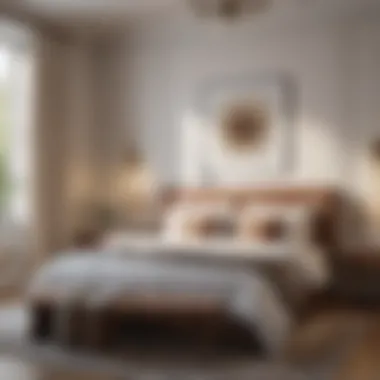
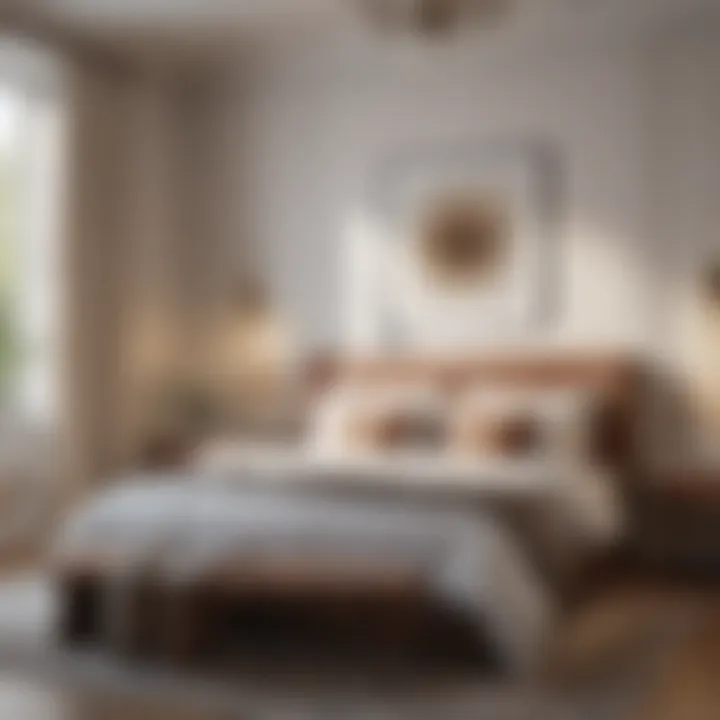
Intro
The spare bedroom often sits dormant, an untouched area that holds potential. It can become a multifunctional space, serving as anything from a guest room to an office or a personal retreat. In this guide, we explore various design ideas that maximize function while creating an inviting atmosphere. We delve into current trends and provide visual concepts that inspire transformation.
Current Trends
Staying updated with trends is vital for optimizing interior spaces. For spare bedrooms, this means understanding which designs resonate with contemporary style and functionality.
Color Palettes
They play a key role in setting the mood of any room. Soft hues such as pastels and neutrals are popular choices for spare bedrooms. These colors promote relaxation and create a serene environment. Alternatively, bold colors or accent walls can add personality and make a statement.
- Beige and soft blues set a calming vibe.
- Forest green can introduce a touch of nature.
- Neutrals paired with dark accents offer sophistication.
Popular Styles
The styles that dominate bedroom design are diverse. Some common trends include:
- Minimalism: Clean lines and clutter-free spaces are essential. Furniture is functional, with less emphasis on decoration.
- Bohemian: This style embraces vibrant colors and textures, creating a cozy yet eclectic feel. Layering fabrics and incorporating plants can enhance this aesthetic.
- Scandinavian: Focused on simplicity, this style emphasizes natural light and comfort. Functionality and elegance blend seamlessly.
Visual Ideas
Visual representation can be a guiding light. Understanding how design changes can impact the room makes decision-making easier.
Gallery of Styled Bedrooms
Inspiration can come from various sources, such as magazines and social media. Visual galleries that showcase different styles and configurations prove invaluable. Options can be tailored to fit unique tastes.
Before-and-After Transformations
Seeing a drastic change can provoke creativity. Here, we highlight the benefits of redesign. Before-and-after photos depict the transformative power of design, illustrating how simple updates can shift the room's entire atmosphere.
Transformation highlights the potential of neglected spaces. A few changes can create a fully functional and aesthetically pleasing room.
Design is not solely about appearance but also about making a space that feels welcoming and serves multiple purposes. Combining trends with personal style provides the foundation for a successful spare bedroom overhaul.
Prelims to Spare Bedroom Design
The concept of spare bedroom design encompasses a multitude of elements that influence a homeowner's ability to maximize the functionality and aesthetic of an often overlooked space. This section sets the stage for understanding the significance of thoughtful design in optimizing a spare room for various purposes, ranging from guest accommodation to personal retreats. The spare bedroom can transform into a multi-faceted area that provides comfort and style, reflecting the owner's taste while increasing the utility of their home.
Importance of Design
Design is essential because it not only affects the aesthetic appeal of a room but also impacts how users experience that space. A well-designed spare bedroom can facilitate relaxation and comfort, ultimately enhancing a visitor’s stay. When aesthetically pleasing and functional, the room can become a preferred area in the home, rather than just a storage site for unused items.
Additionally, a thoughtfully designed room represents an investment in one’s living environment. It elevates the overall home atmosphere and can increase property value. Furthermore, the design can serve as a reflection of personal style and preferences, making the home feel more cohesive and welcoming.
Understanding Space Utilization
Space utilization revolves around how effectively a room’s layout serves its intended purpose. In the context of a spare bedroom, it is crucial to visualize how the space can be organized depending on its function. An important factor is assessing the physical dimensions of the room, which dictates the type of furniture and arrangements that can be implemented.
There are a few considerations to keep in mind when thinking about space:
- Layout: The arrangement of furniture should enable free movement while encouraging the intended activities of the room.
- Furniture Size: Multi-functional furniture can help optimize space while providing necessary comfort and utility.
- Natural Light: Utilizing the natural light sources available in the room can enhance the overall comfort level, making it more inviting.
An aspect to remember is that:
Space is not just about physical dimensions; it's about how that space is experienced.
In summary, the introduction to spare bedroom design highlights the potentials of this often underappreciated space. A focus on design will ensure that the room is functional, aesthetic, and adaptable to the homeowner's needs.
Defining the Purpose of the Spare Bedroom
Understanding the purpose of a spare bedroom is essential in the design process. It allows homeowners to tailor the space to meet specific needs, which can enhance both functionality and aesthetic appeal. Recognizing how the room will be used informs all design choices, from furniture selection to decor aesthetics. This approach not only maximizes the potential of the space but also ensures that it serves a useful role in everyday life.
Guest Accommodation
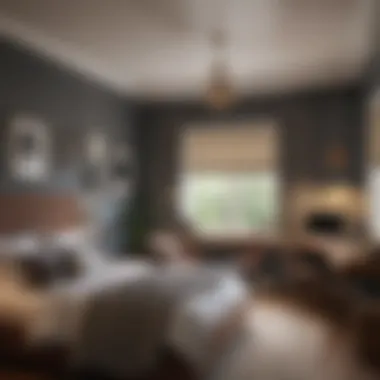
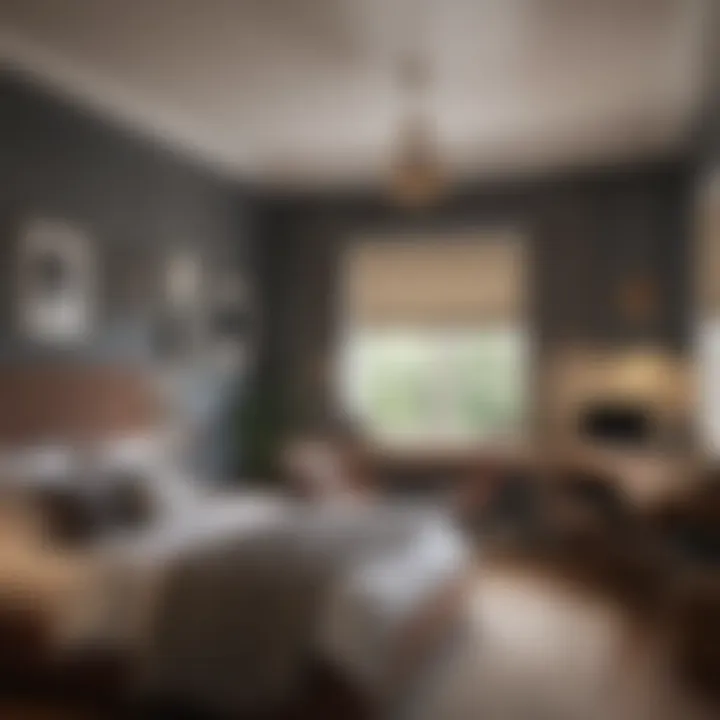
One of the common purposes of a spare bedroom is to serve as guest accommodation. This is particularly valuable for those who frequently host friends or family. The design should focus on comfort and hospitality. A decent bed is imperative, complemented by quality bedding to ensure a restful sleep for guests.
Additionally, consider including a bedside table for essential items like books or a glass of water. Thoughtful touches, such as extra pillows and blankets, show consideration and provide added comfort.
Mood lighting can also contribute to a welcoming atmosphere. Using lamps with soft illumination creates a relaxing environment for visitors. Moreover, adding personal touches, like framed photos or artwork, can make the space feel more inviting.
Home Office Space
Another viable option for a spare bedroom is to transform it into a home office space. With the rise of remote work, this purpose is becoming increasingly popular. A well-designed home office can enhance productivity and focus.
Start by choosing a suitable desk and ergonomic chair that suits both the style and comfort needs. Adequate lighting is crucial; natural light is best if available, but task lighting should also be considered to minimize eye strain during long working hours.
Organizational tools such as shelves or cabinets can keep the space tidy and efficient. Remember to personalize the workspace with items that inspire creativity. The overall design should foster a professional atmosphere while also reflecting individual style.
Creative Studio or Hobby Room
The third option to consider is utilizing the spare bedroom as a creative studio or hobby room. This can be incredibly fulfilling for those with artistic or crafting passions. The layout should be functional and cater to the specific activities to be conducted in the room.
For artists or crafters, ample storage is necessary to organize supplies. Utilizing multi-functional furniture can optimize space. For instance, a table that doubles as a workspace and storage area can be incredibly beneficial.
Moreover, good lighting is essential to inspire creativity. Natural light enhances mood and fuels creativity, while additional task lighting can be beneficial for detailed work in the evenings. Personal inspiration, like mood boards or finished projects, can add both a personal touch and motivation.
Each of these purposes highlights the versatility of spare bedrooms. By defining the room's purpose, you can guide your design decisions more effectively, creating an environment that meets your needs.
Design Ideas for Functionality
When designing a spare bedroom, functionality takes precedence. It is essential to create a space that caters to multiple needs without compromising comfort. Functional design ensures that every item serves a purpose. This allows for efficient use of space and enhances the overall living experience. Homeowners often struggle with the underutilization of spare rooms. Therefore, focusing on functional design ideas can transform these rooms into valuable assets.
Multi-Functional Furniture
Murphy Beds
Murphy beds are a prime example of versatile furniture. They easily fold away, providing valuable floor space during the day. This specific aspect of Murphy beds allows the room to serve an additional purpose, such as a living area or a workspace. Their key characteristic is the space-saving design; this aspect makes them a popular choice for optimizing smaller bedrooms. A unique feature of Murphy beds is the variety of styles available, from modern to traditional. The advantages include allowing for efficient space management. However, a potential disadvantage may be the initial cost or the need for wall reinforcement during installation.
Convertible Sofas
Convertible sofas are another smart solution for maximizing space. They function as a couch by day and convert into a bed at night. This adaptability is crucial for a spare bedroom that needs to accommodate guests. The key characteristic of convertible sofas is their dual function, which makes them desirable for this design concept. An important unique feature is the ease of transformation into a bed, catering to both guests and daily comfort. One advantage is the added seating in the room, but a disadvantage can be comfort levels compared to a traditional bed.
Storage Ottomans
Storage ottomans offer a stylish way to gain extra storage. They can be used as footrests or additional seating. This multifunctionality is a significant aspect of storage ottomans. The key characteristic is their concealed storage, which helps keep the room tidy. They are beneficial because they enhance both style and organization within the space. A unique feature is the ability to choose from various designs and materials to fit the room’s aesthetic. However, their storage capacity can be limited compared to larger storage solutions.
Smart Storage Solutions
Under-Bed Storage
Under-bed storage provides an excellent way to utilize often wasted space. This type of storage is ideal for keeping seasonal items or extra bedding organized. Its key characteristic lies in the clever use of space beneath the bed. It's a beneficial choice as it promotes decluttering, which is vital in designing a functional spare bedroom. A unique feature is the variety of storage options available, such as drawers or rolling bins. However, a disadvantage is the need for consistent organization to ensure easy access to stored items.
Shelving Units
Shelving units can play a significant role in space management. They provide an opportunity to display decorative items while also offering additional storage. Their key characteristic is versatility, as they can be placed in various arrangements to suit design preferences. A beneficial choice, they maximize vertical space, making the room feel larger. A unique feature is the ability to add or rearrange shelves as needed. However, a disadvantage may include the potential accumulation of clutter if not organized properly.
Baskets and Bins
Baskets and bins serve a dual purpose: they enhance decor and provide practical storage. This specific aspect allows for tidiness while adding personal style. One key characteristic is their portability, which makes them easy to move when cleaning. They are a popular and beneficial choice due to their versatility and variety of styles. A distinctive feature is the range of materials available, from woven to plastic. A disadvantage could be that small items may easily get lost in larger baskets without proper organization.
Aesthetic Considerations
Aesthetics play a critical role in transforming a spare bedroom not only into a practical space but also a visually appealing one. It sets the tone for the entire room, influencing the ambiance and emotional response of its users. The right aesthetic choices can create an environment that feels both inviting and relaxing. When homeowners consider aesthetics, they engage with elements such as color, décor, and lighting that work together to compose a cohesive design.
Color Palette Selection
The selection of colors is fundamental in establishing the mood of any room. In a spare bedroom, it is essential to look for hues that evoke calmness and serenity—soft blues, gentle greens, and neutral tones are often recommended. These colors can create a soothing retreat for guests and the homeowners alike. The color palette can also impact light reflection, making smaller rooms feel more spacious or cozy, depending on the intent.
Color also has psychological effects. For example, shades of blue promote relaxation while yellow adds cheerful warmth. When choosing a palette, consider the overall function of the room and the feelings you want to elicit. A carefully curated color scheme allows for easier integration with furniture and decorative elements, leading to a unified design.
Choosing Appropriate écor
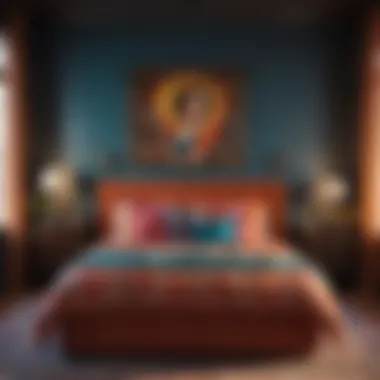
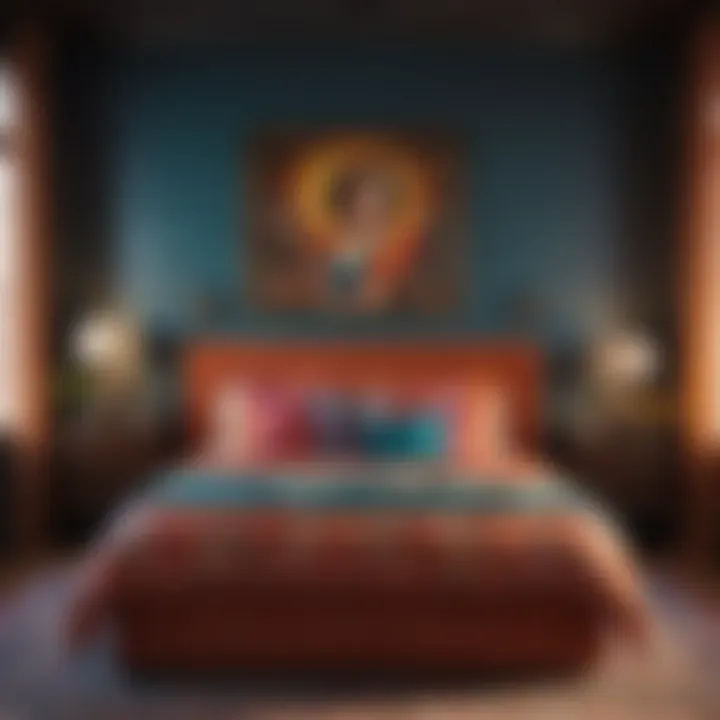
Wall Art
Wall art serves as a focal point within a room. It captures attention and expresses personal taste. Varieties range from framed photographs to canvas paintings or even a curated gallery wall. A significant advantage of wall art is its versatility; it can reflect the personality of the occupant and enhance the theme of the room.
One aspect to keep in mind is scale. Oversized pieces can dominate a small space, while smaller art may get lost on large walls. Choosing the right size can emphasize the room’s dimensions and enhance its aesthetic appeal. However, be cautious with the styles chosen; not all art will suit all themes, and clashing styles can disrupt cohesion.
Textiles and Bedding
Textiles and bedding are crucial in creating a welcoming atmosphere in a spare bedroom. They provide comfort and warmth while contributing to the overall color and texture of the space. Soft, high-quality fabrics can elevate the room's aesthetic, making it feel more luxurious.
Consideration should also be taken for the durability of textiles, especially if the room is frequently used by guests. Choose materials that are easy to clean yet comfortable to maintain, such as cotton or linen. Additionally, layering different textures can create depth and visual interest without overwhelming the space.
Lighting Fixtures
Lighting is another pivotal element of aesthetic design. Fixtures can impact both functionality and the ambiance of the spare bedroom. A well-lit room appears larger and more inviting. Different types of lighting, such as ambient, task, and accent lighting, should be layered for optimal effect.
Select fixtures that align with the chosen design theme; for example, modern pendant lights may fit well in a minimalist space, while vintage sconces could enhance a traditional feel. Furthermore, natural light should be harnessed to its fullest potential, amplifying mood and energy efficiency. Consider blackout curtains or adjustable blinds to control light exposure effectively without sacrificing aesthetics.
"A focus on aesthetics not only beautifies a space, but also enhances the overall living experience."
In summary, aesthetic considerations are vital when designing a spare bedroom. Careful selection of colors, décor, and lighting can create a space that is not only functional but also inviting and pleasing to the eye.
Incorporating Personal Style
Personal style adds a unique touch to any space, and spare bedrooms are no exception. When designing this room, it is essential to reflect individual tastes and preferences. A personalized space not only enhances comfort but creates an inviting atmosphere for both the homeowner and guests. Understanding how to incorporate personal style into the design process can make the room feel like an extension of one's personality.
The benefits of incorporating personal style are numerous. Firstly, it fosters a sense of belonging. A room that showcases one’s interests and experiences provides comfort and serves as a sanctuary for relaxation. Secondly, it encourages creativity. Personal touches inspire elements of self-expression, allowing for an environment that motivates and revitalizes.
Considerations when incorporating personal style include balancing personal preferences with practicality. It is crucial to select items that not only represent one's personality but also serve a purpose in the overall room design. Keeping a cohesive theme can make the bedroom aesthetically pleasing, while simultaneously functional.
Design Themes
Minimalist Designs
Minimalist designs focus on simplicity and functionality. This design approach contributes to creating an uncluttered and serene environment. The key characteristic of minimalist designs is their emphasis on clean lines and a lack of excessive decoration. This makes them a beneficial choice for spare bedrooms, especially if space is limited.
The unique feature of minimalist designs is their ability to utilize space efficiently. The absence of excessive furnishings allows for a sense of openness that can be calming. However, one disadvantage could be the risk of the room feeling sterile or uninviting if not executed thoughtfully.
Coastal Vibes
Coastal vibes evoke a relaxed, beach-like atmosphere. This design approach contributes to a soothing environment, ideal for a spare bedroom meant for rest. The key characteristic of coastal vibes is the use of light colors and natural materials. These elements help in creating a refreshing and airy feel.
The unique feature of coastal vibes is the ability to seamlessly integrate outdoor elements, such as natural light and greenery. This likely enhances tranquility and relaxation. However, it's essential to find the right balance; overdoing coastal elements can veer into cliché.
Traditional Styles
Traditional styles bring warmth and familiarity to a room. This approach adds character, contributing to a timeless appeal that many homeowners prefer. The hallmark of traditional styles is their rich colors and classic furnishings that evoke a sense of history.
The unique feature of traditional styles lies in their versatility. They can complement a variety of aesthetics and are generally always in vogue. Yet, a potential disadvantage is that traditional styles can become outdated. Being mindful of selected pieces can help retain their relevance over time.
Accent Features
Accent Walls
Accent walls are powerful design elements. They can dramatically enhance the overall feel of a spare bedroom by adding depth and interest. The main characteristic of an accent wall is its bold color or pattern, which draws the eye and serves as a focal point.
The unique feature of accent walls is their ability to change the entire vibe of a room without much effort. However, selecting the wrong color or pattern can overpower the space, making it essential to choose carefully.
Unique Furniture Pieces
Incorporating unique furniture pieces infuses character into a spare bedroom. These items can provide functionality while also making a statement. The main characteristic of unique furniture is its distinctive design or color.
The unique feature of such pieces is their capacity to spark conversation. Nevertheless, it is crucial to ensure they fit within the overall design scheme and do not clash with existing décor.
Personal Collections
Personal collections add individuality to a spare bedroom. They can serve as both decoration and sentimental reminder of cherished experiences. The key characteristic of personal collections is their variety, driven by the owner’s interests.
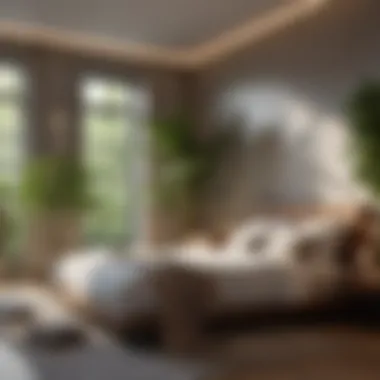
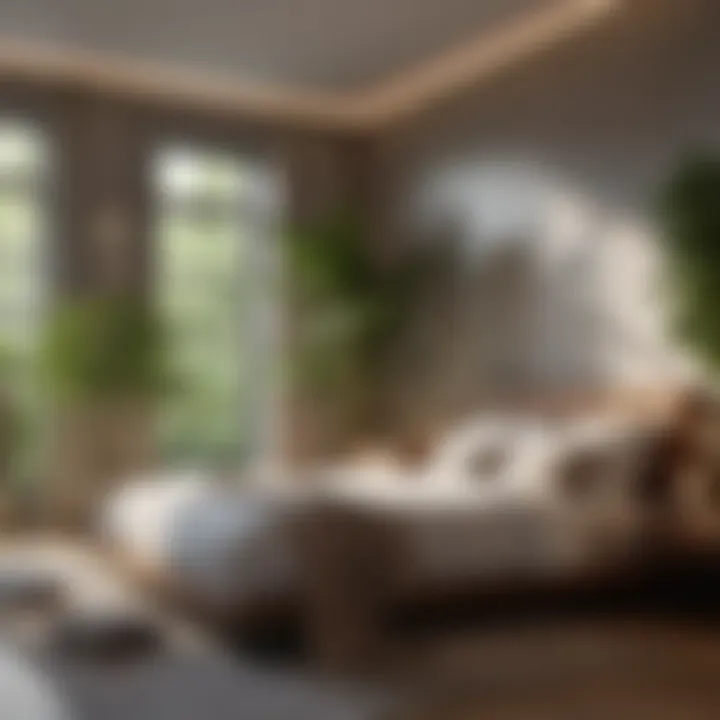
The unique aspect of personal collections is they either provoke memory or conversation. However, they can also clutter a space if not displayed thoughtfully. It is essential to curate and showcase these items meaningfully.
Creating a Comfortable Environment
Creating a comfortable environment in a spare bedroom is critical to its overall utility and appeal. A well-designed space not only welcomes guests but also provides a retreat for relaxation and rejuvenation. Comfort involves various aspects, including bedding options, climate control, and aesthetics. The goal is to make the room a sanctuary that balances coziness with functionality.
Optimal Bedding Choices
Bedding is a fundamental aspect of comfort. Choosing the right mattress and bedding materials can significantly enhance the sleeping experience.
- Mattress Selection: A quality mattress contributes to good sleep. Consider mattress types such as memory foam, innerspring, or hybrid mattresses. Each type has unique benefits—memory foam can provide contouring support, while innerspring models often offer a cooler sleeping surface.
- Bedding Fabrics: The choice of sheets, duvet covers, and pillowcases should prioritize breathability and comfort. Cotton and linen are preferred options due to their softness and moisture-wicking properties.
- Layering: Layering bedding with blankets and throws can add warmth and texture, allowing for comfort adjustments based on personal preference.
The right bedding not only enhances comfort but also reflects personal style, tying in with the overall room design.
Climate Control Considerations
Managing the room's climate is essential for maintaining comfort throughout the year. Proper heating and cooling options, along with airflow management, play a critical role in achieving a pleasant temperature.
Heating and Cooling
Heating and cooling systems are crucial for regulating temperature, ensuring that the spare bedroom remains inviting.
- Key Characteristics: Modern solutions such as smart thermostats and energy-efficient heaters can provide consistent temperature control while minimizing energy waste.
- Benefits: A well-regulated environment leads to improved comfort and better sleep quality. For instance, studies show a temperature range of 60-67°F facilitates better sleep.
- Challenges: While central heating and cooling systems offer convenience, they may lead to uneven temperatures throughout the home. A targeted approach using space heaters or window AC units can provide more direct control in a spare bedroom.
Airflow Management
Effective airflow management contributes to overall comfort in a spare bedroom by preventing stagnant air and facilitating a fresh atmosphere.
- Key Characteristics: Ceiling fans, window placements, and ventilation systems are common methods to achieve optimal airflow.
- Benefits: Good airflow enhances the effectiveness of heating and cooling systems, making temperature regulation more efficient. Increased airflow can also reduce humidity, making the space feel cooler in warm months.
- Unique Features: Consider installing adjustable vents or using portable fans to tailor airflow according to personal needs. However, it is essential to balance airflow with noise levels, as excessive sound can disrupt sleep.
Proper climate control and airflow can significantly influence the room's comfort level.
By paying careful attention to bedding choices and climate control measures, you can create a space that feels warm and inviting, ready to accommodate guests or serve as a personal retreat.
Incorporating Wellness Elements
Incorporating wellness elements into the design of a spare bedroom can enhance the overall comfort and functionality of the space. This approach emphasizes the importance of creating an environment that promotes relaxation and rejuvenation. Considering the physical and mental health benefits, elements like natural light and greenery can greatly impact how the space is perceived and used. A focus on wellness turns a merely functional room into a holistic retreat.
Natural Light Utilization
Natural light plays a significant role in enhancing mood and well-being. This element is crucial for any design aimed at promoting a sense of serenity. When planning the layout of a spare bedroom, prioritize window placement. Large windows or strategically placed mirrors can amplify light availability in the room.
In addition to aesthetic appeal, natural light can influence productivity and sleep patterns positively. A room filled with soft sunlight during the day can help regulate circadian rhythms, aiding in better sleep at night. Consider the type of window treatments as well; light, airy fabrics can filter light without blocking it entirely, ensuring the room feels bright and inviting.
Incorporating Greenery
Indoor Plants
Indoor plants bring numerous benefits to a spare bedroom design. They are not only visually appealing but also contribute to improved air quality. Many popular species, such as the snake plant and peace lily, are known for their ability to filter toxins from the air. This characteristic makes them a valuable addition to any indoor environment aimed at wellness.
Furthermore, indoor plants are regarded as a calming presence. Studies suggest that having greenery in your living space can reduce stress levels. They require minimal care, fitting well with the concept of a low-maintenance bedroom. However, it is worth noting that some plants may have specific light requirements, influencing their placement decisions.
Herb Gardens
Herb gardens add another layer of wellness to the spare bedroom. Having fresh herbs like basil or mint readily available not only enhances meals but also contributes to a sense of tranquility. Growing herbs indoors provides an opportunity for engagement with nature, fostering a nurturing environment.
The unique feature of herb gardens lies in their dual purpose: they serve as both décor and functional elements. Fresh scents from herbs can improve mood and create a welcoming atmosphere in the room. On the downside, maintaining an herb garden requires regular watering and attention to light conditions. It is crucial to choose the right spot to ensure the plants thrive, which makes them somewhat demanding compared to traditional indoor plants.
In summary, both natural light and greenery play crucial roles in creating a spa-like atmosphere in a spare bedroom. These wellness elements not only benefit the design aesthetic but also enhance the health and happiness of the occupants. Integrating them thoughtfully can lead to a perfectly balanced and rejuvenating space.
Final Thoughts
Designing a spare bedroom is more than just aesthetics; it’s about creating a space that serves multiple needs without compromising style. The concept of this section highlights the interplay between functionality and visual appeal, ensuring that the room remains practical while also reflecting the homeowner's personal taste.
Achieving Balance Between Functionality and Aesthetics
Finding the right balance between functionality and aesthetics in spare bedroom design is crucial. Homeowners often face the challenge of making the room usable while also ensuring it looks inviting.
- Functional Furniture: Selecting furniture that serves more than one purpose is a key step. A combination of a bed, workspace, and storage options allows for smooth transitions between different activities. Examples include convertible sofas, which can serve as seating during the day and a bed at night.
- Design Cohesion: It’s essential to maintain a cohesive design theme, which enhances the overall look without making the space feel cluttered. Each piece should contribute to the intended ambiance. For a quieter feel, opting for minimalistic furniture enhances the serene environment.
- Color Scheme and Lighting: Choosing a color palette that complements the room’s purpose can establish the mood. Soft, neutral colors create an open atmosphere, while warm tones can make the space feel cozy. Coupled with appropriate lighting choices, such as layered lighting with ambient, task, and accent options, the room can be functional yet aesthetically pleasing.
- Emotionally Resonate: The room should also evoke feelings of comfort. Adding personal touches, like family photos or souvenirs, promotes emotional connection and makes the room truly yours.
Balancing functionality with aesthetics requires thoughtful planning but yields a space that is both inviting and versatile. Successful design acknowledges that a spare bedroom can be more than just a guest room; it can also be a personal retreat or a productive workspace.
"A well-designed space harmonizes functionality with beauty, inviting all who enter to experience its utility and charm."



